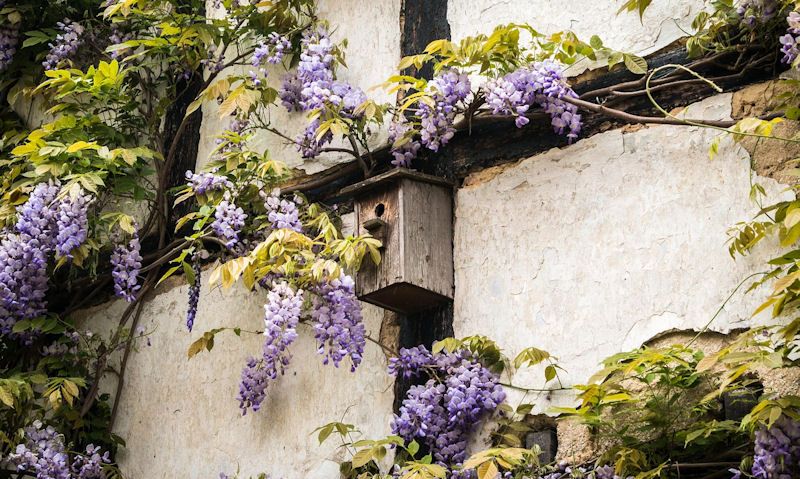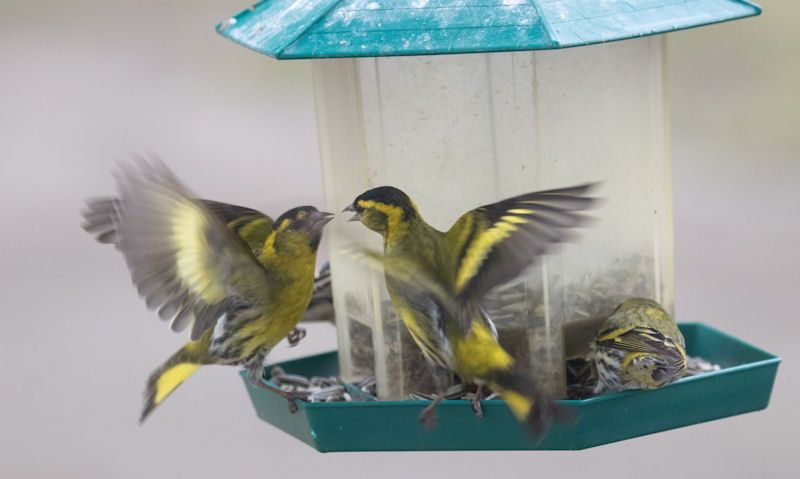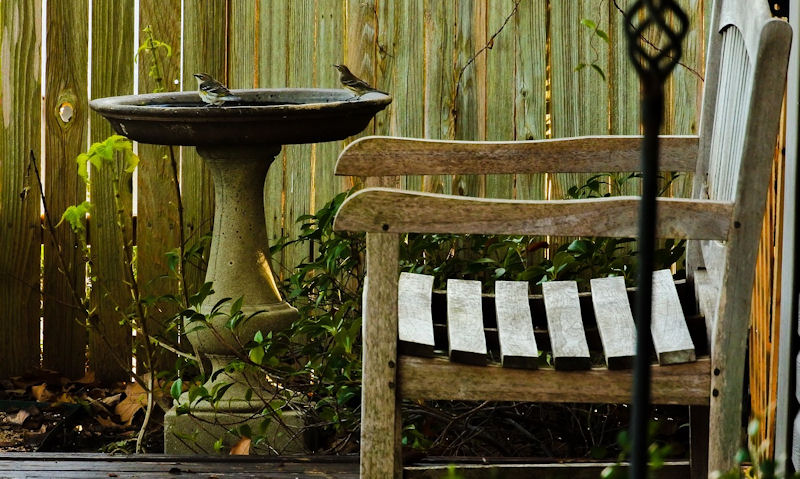Where to site a bird box
Attracting a wild bird to nest in your box relies heavily on location, with the best place to put a bird box depending on which birds you would like to nest.
Where you site a bird box depends on the species its made to attract; multi-use bird boxes will attract all small garden birds if sited in a quiet spot. Likewise, a Sparrow box needs to be sited high up under the eaves, so does one for a Swift, boxes can be located in garden or out in the woods.
Before scouting a location for the bird box, remember the box at some point will need cleaning out, so it needs to be placed where its within reach.
Taking advice from the experts, regardless of bird box placement, it must always be facing away from the sunshine at all times, and facing away from the chilliest winds.
Well most common bird nesting boxes for small garden birds will need to be sited with a clear line of sight, other birds require there box to be located in a more dense location, deep in plantation.
Site your bird box anywhere from 3 to 4 metre high, well a wall backing is the best area to fix a box, followed by a solid tree.
Bird box location chart:
| Bird: | Location: | Height: | Area: |
|---|---|---|---|
| Barn Owl | outhousing | 3 - 4m | eaves, trees |
| Blackbird | garden | 1 - 2m | ivy, trees |
| Blue Tit | garden | 2 - 4m | multi-use |
| Coal Tit | garden | 2 - 4m | multi-use |
| Great Tit | garden | 2 - 4m | multi-use |
| House Martin | garden | 4 - 6m | eave |
| House Sparrow | garden | 2 - 4m | multi-use |
| Jackdaw | outhousing | 4 - 6m | eaves, trees |
| Kestrel | outhousing | 4 - 6m | eaves, trees |
| Marsh Tits | garden | 2 - 4m | multi-use |
| Nuthatch | garden | 2m | multi-use |
| Pied Flycatchers | garden | 2 - 4m | ivy, creeper |
| Pied Wagtail | garden | 2 - 4m | ivy, creeper |
| Robin | garden | 2m | ivy, creeper |
| Starling | garden | 2 - 4m | multi-use |
| Spotted Flycatcher | outbuildings | 4 - 6m | eave, tree |
| Stock Doves | outhousing | 2 - 4m | trees |
| Swifts | outbuildings | 3m | eave |
| Swallow | outbuildings | 3m | eaves |
| Tawny Owl | woodland | 3 - 4m | tree, building |
| Tree Sparrow | woodland | 2 - 4m | tree |
| Woodpecker | woodland | 3 - 5m | multi-use |
| Wren | garden | 2m | multi-use |
Easy access for installer
Whether you're an amateur installing a bird box in the garden or a professional fixing a bird box out in the woods, its always vital you have easy access to the box.
Come the end of nesting season in September to October its time to clean out the bird box of its used materials, with a flash of soapy water before its occupied again.
So with that in mind, the bird box needs to be within reach to gain access to the interior.
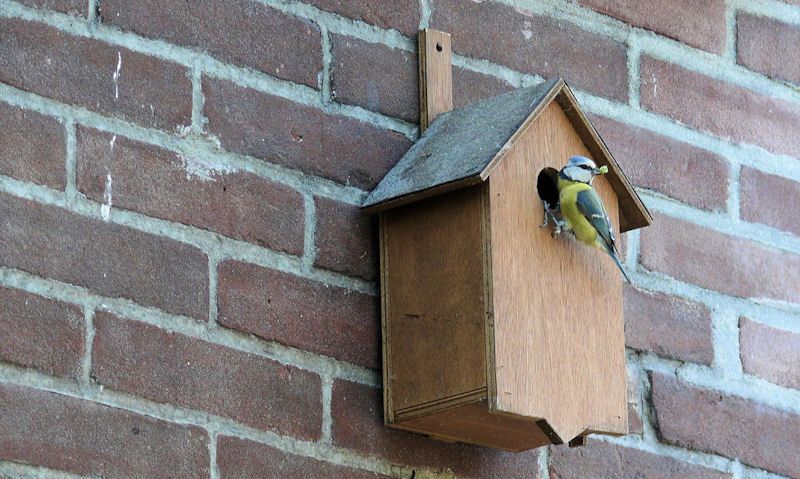
Fixing a bird box in your garden should keep it close to the ground, with a height of no more than 4 metres in most cases, so a ladder would be needed.
Likewise, if you've installed a bird box in the woods for an owl or woodpecker, you will still need access for mopping out at the end of the nesting season.
If installing a bird box in the woods for either species, know that it will be located deep in the woods so the sunshine will not be an issues.
Though if its on the outskirts of the woods facing south, obscure the box in an area that is shaded around the clock, but still allowing birds a clear line of sight.
Facing box the right way
Well this primarily refers to those you wish to site a bird box in the confines of there own garden, it will apply to those that locate boxes in woodlands.
Always, always make sure your bird box is facing between north and east.
To determine which way is north, east or north/east, checkout where the sun is in the sky from noon to midday, as it rises from the east in the morning before disappearing over the horizon in the west.
Though this varies drastically during the year, but a north and east face is best.
Unless there are trees or buildings which shade the box during the day, face the box between north and east, thus avoiding strong sunlight and the wettest winds - RSPB
Taking advice directly from the horses mouth, the RSPB recommend facing the bird box north and east, with a few exceptions.
If bird box placement is in a shaded area with overlooking houses or big trees for example, you may be free to locate the bird box where you wish.
You just need to make sure the box remains in the shade during the whole day as the sun moves around.
Clear flight path
Regardless of the bird box or location, is must always have a clear line of sight for the birds to enter and exist the box.
In an area where plantation over time will grow level with the bird box entrance hole, those obstructing the bird coming and going, this would be a problem.
Further to this, if a bird box is fixed to a wall or fence where ivy is on that same wall, well its fine for the ivy to crawl around the box, keep it away from the entrance hole.
By this we mean it would require you to cut back the ivy as it grows slowly towards the hole, so cut it way back so to not disturb the birds inside anytime during the year.
If siting a bird box for a Robin or Wren, they prefer there box to be placed low and way back in vegetation, so they don't require a clear line of sight.
Instead they need the box to be buried deep in plantation, but still in the shade.
Where NOT to place a bird box
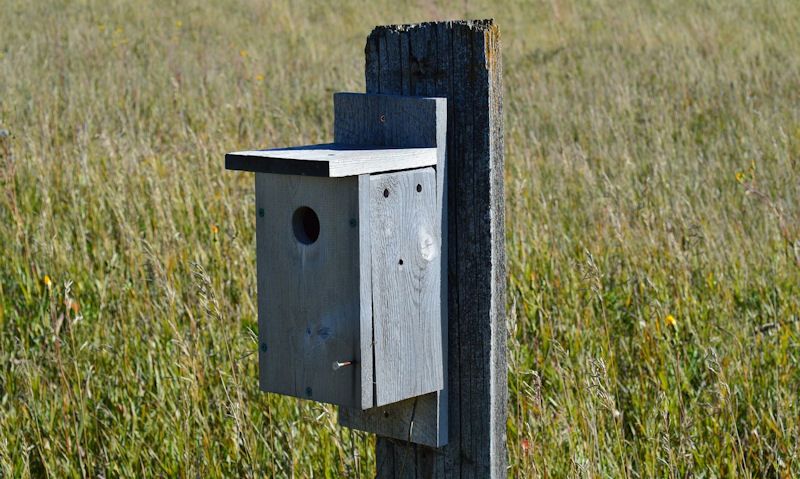
Well we talk about the best place to put a bird box, let's not forget there are some horrid places that could be used, which are never recommended.
Well in some cases it may be fine to put a bird nesting box on a fence post, for most of us in built up areas, that same fence post is easily accessible by cats.
Now its possible for the cats to use the fence has a perch, ready to pounce on the bird well entering - or more likely - existing the bird box.
Well most garden fence panels are no higher than 5 feet, this is way below the recommended height to site a bird box, so should never be considered.
Likewise, if you have the nice tree in your garden that is perfect to hang a bird box from, make sure its not a tree that has cats that climb up now and then.
If you're near woodlands, visiting squirrels to your garden could access the box to steel the eggs via the tree, so make sure you are not visited by these common bird predators.
On place not to locate a bird box which many do is the backing of a plank of wood buried into the ground.
A bird box located here are highly vulnerable to high winds and falling debris in storms.
Well the wood weathers before rotting over the years, it could possibly break with the occupents still in the box.
Location by species
Its not a simple case of one location fits all, in fact, depending on the bird species, you need to carefully site your box according to there requirements.
Most small garden birds will be happy with a multi-use bird box with a hole no larger than 25mm, so a wall would be the place to put a bird box.
Similarly, if you're catering for House Martins or Sparrows, then you need a good space below the house roof, with a wide, overhanging eave.
Allow us to go into more detail according to the bird you wish to site a bird box for:
Tit family: Blue Tit, Marsh Tits, Coal Tit, Great Tit
You don't have to worry to much about where to place a bird box for Blue Tits, Coal Tits and Great Tits, as all will take to a simple multi-use bird box.
What you will need to do is place the box from 2 to 4 metres high off the ground, with a wall backing providing the best possible security.
Higher the box the safer it becomes, but again it needs to be accessible by you.
House Martin
Locating a bird box for a House Martin takes some work, so be absolutely sure you have House Martins close by to tempt them to nest in your box.
Where you place there bird box is high up in the eaves of the house on the outside, with a clear line of sight, but still on the front or back side of the house away from the sun.
It will be difficult to fix a House Martin bird box but you only need to do it once. Its also best you don't put anything in there bird box but it will still need cleaning out.
House Sparrow
In regard to House Sparrows, you can be pretty nimble where you site there bird box, but it has to be an area large enough to accommodate multiple boxes.
As Sparrows are colony nesters, its recommended you line up to 3 or 4 boxes side by side, or buy a Sparrow colony box with separate compartments.
Site the box high up near the roof on the house, or use a high wall in the garden.
Jackdaw
If you're thinking about fixing a bird box for Jackdaw's, then your garden would be situated out in the country, near woods with possibly outhousing.
Fixing a Jackdaw bird box should be sited high up on an unused outbuilding, though a box placed on a tree trunk may be a better proposition.
Jackdaws demand isolation from people of busy areas, so make sure its in a wooded area if you can with plenty of shade covering the entrance hole.
Nuthatch
If siting a bird box for Nuthatch, then its best to fix high up on a tree trunk only, anywhere else and you may find it hard to attract them to the box.
Of fixing the bird box to a tree, make sure the box you've bought has suitable fixings to hang the bird box to a tree, avoiding the hassle of connecting fixings yourself.
Look out for a woodcrate bird box that has a big metal hook you can hang off a branch.
Robin, Wren
When siting a bird box for Robins the same location can be used to place a bird box for a Wren, as both boxes look similar, with both species taking to it.
Well both bird boxes are fixed only 2 metres off the ground, but a little lower is suitable.
Placing the box deep in plantation is ideal, well providing cover from predators, and keeping the sunshine away with plenty of shade.
Starling
Starling bird boxes are fairly big, certainly much bigger than those multi-use bird boxes used by small garden birds.
So with that in mind, you need a location for the bird box that is suitable for its size.
High up on the side of the house wall would be best, but so would a large tree with a big, wide trunk the backing of the bird box will stay secured on.
Swifts
The swift is a bird found in Britain that spends most of its time in the air, even taking to sleeping on the wing well using thermals to rise to great heights.
Swifts can't nest in the air for obvious reasons so a bird box needs to be used on the ground, providing they don't take to one they've made themselves.
When siting a bird box for a Swift use the same location outlined for the Sparrows, only its not a colony box but a fairly big one placed high up on the house eaves.
Siting less common boxes
Now that we've explained in detail where the best place to site a bird box for the most common garden visitors, lets take a look at suitable spots for less common birds.
What we mean by that is finding sites for a bird box that is used for nesting or roosting wild birds that don't usually take to bird boxes setup in the garden.
Well a terraced house or town house would be out of the question for the following bird species, a house on the outskirts of the city or countryside home will benefit the most.
Pied Flycatchers
To site a box for the more rarer Pied Flycatcher, you need to think about an area in your garden that is covered in ivy, with the possibility of it covering the box in due course.
If not then it would be recommended to fix a Pied Flycatcher bird box deep in your garden creeper feature.
It should have blooming plants or leaves all year round, making good cover for a box that should be sited 2 to 4 metres high.
Pied Wagtail
Securing a bird box for a Pied Flycatcher can be replicated to attract a Pied Wagtail.
The garden should be located near the woods if you're to attract them, but a built up garden with overflowing leaves on creepers would be a good start.
If you haven't already, head to the garden centre and begin the process of growing creepers up and around your garden gazebo or trellis.
Later, you might just be able to entice a Pied Wagtail to nest or roost.
Spotted Flycatcher
Take all advice outline for the Pied Wagtail and Pied Flycatcher as it all applies to a bird box for a Spotted Flycatcher.
Well the box needs to be sited 4 to 6 metres off the ground, the backing of a brick wall or tree would be significant enough.
Better still, if you have a solid trellis fixed to the wall then bury the unique design of the Spotted Flycatcher bird box deep into the blooming leaves, weeds and ivy.
Stock Doves
Unlike the common Woodpigeon found across the country in most towns and cities, the rather similar Stock Dove can nest in a bird box.
Furthermore, it will only take to wooded areas with a nesting box attached to a tree 2 to 4 metres up on its trunk.
A rather large bird box that would require the help of up to two people, but only the one needed to clean it out when the nesting season is over.
Swallow
Bird boxes that replicate a nest Swallows build in the wild is not the wooden bird box we know; its rather made from an assortment of materials that creates a cup-like nest.
Like there real nests, a store-bought Swallow nest box needs to be placed up high under the eaves of your house, as much a 3 to 4 metres high.
Where you site the box is far up under the flat surface above it, with only an inch gap for the Swallows to come and go.
Into the woods
Away with the common garden birds and the rarer species, now lets turn our attention to common wild birds that prefer to have a bird box setup in woodlands only.
We're of course talking about owls and Kestrels, the Tree Sparrow and Woodpeckers, with the 'wood' in the name of the last two, so the clue is in the name.
And well all species could take to a bird box sited in a garden near the woods, ideally a box should be placed deeper into the woods with continuous shade throughout the day.
In the case of owls or Kestrels who are birds of prey, they will need a clear outlook on open farmlands and fields.
Barn Owl
The Barn Owl nest box should be sited high up under the eaves of a barn or outhouse, with a clear line of sight these larger birds absolutely require to stretch there wings.
If fixing the box inside the building it should be an old, abandoned building with enough room up in the rafters to fix the box, allowing owls to escape if need be.
If securing the box outside, make sure its on the building facing away from the sun and wind, but still accessible by you to fix it, before clearing it out later on.
Tawny Owl
When fixing a Tawny Owl bird box we have to take a different approach as the one we've used to site a Barn Owl bird box.
Largely due to the design of the box ruling out siting it to the eaves or rafters.
Instead, the Tawny Owl box should be strapped to a tree trunk that is overhanging or at least on an angle with cover to keep the wet out.
Finding the perfect location to site a Tawny Owl box takes time, but when you do make sure its at least 3 to 4 metres off the ground.
Tree Sparrow
Well a House Sparrow is happy to set up home in the busy suburbs, the Tree Sparrow requires seclusion in the woods.
And again, it takes a row of small bird boxes or a purpose built Sparrow colony box in one, as they're colony nesters.
Up to three entrance holes are drilled in to these boxes with 3 separate compartment, so its vital all three entrance holes face away from the sunshine and stay in the shade.
Woodpecker
Its in the name, a Woodpecker - or more specifically - a Great Spotted Woodpecker requires a nesting box fixed to a tree, deep in the woods.
This long box should be fastened to the tree trunk with a deep shaded quiet spot, as much as 3 to 5 metres off the ground.
Make sure the tree is not beaming with life, with the Woodpecker able to settle down in a place undisturbed - or at least until its settled into the box.
Kestrel
Kestrel nesting boxes can only befixed to trees in woodlands with an open outlook for taking flight, so its not one to be fixed in your garden.
If your garden is adjoined with woodlands, it might be possible to fix it so its out of the way, but still overlooking open lands.
Fix the bird Kestrel box on a treewhere the truck splits, making a good area to sit the box on, but it will still need to be fastened to the trunks and solid branches.
Bird box location chart:
| Bird: | Location: | Height: | Area: |
|---|---|---|---|
| Barn Owl | Outhousing | 3 - 4m | Eaves, Trees |
| Blue Tit | Garden | 2 - 4m | Multi-Use |
| Coal Tit | Garden | 2 - 4m | Multi-Use |
| Great Tit | Garden | 2 - 4m | Multi-Use |
| House Martin | Garden | 4 - 6m | Eaves |
| House Sparrow | Garden | 2 - 4m | Multi-Use |
| Jackdaw | Outhousing | 4 - 6m | Eaves, Trees |
| Kestrel | Outhousing | 4 - 6m | Eaves, Trees |
| Marsh Tits | Garden | 2 - 4m | Multi-Use |
| Nuthatch | Garden | 2m | Multi-Use |
| Pied Flycatchers | Garden | 2 - 4m | Ivy, Creeper |
| Pied Wagtail | Garden | 2 - 4m | Ivy, Creeper |
| Robin | Garden | 2m | Ivy, Creeper |
| Starling | Garden | 2 - 4m | Multi-Use |
| Spotted Flycatcher | Outbuildings | 4 - 6m | Eave, Trees |
| Stock Doves | Outhousing | 2 - 4m | Trees |
| Swifts | Outbuildings | 3m | Eave |
| Swallow | Outbuildings | 3m | Eaves |
| Tawny Owl | Woodland | 3 - 4m | Trees, Buildings |
| Tree Sparrow | Woodland | 2 - 4m | Trees |
| Woodpecker | Woodland | 3 - 5m | Multi-Use |
| Wren | Garden | 2m | Multi-Use |
